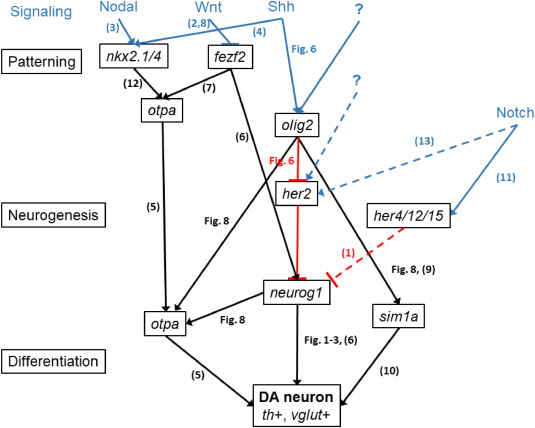Fig. 9 Transcriptional network integrating patterning and neurogenesis signals to control posterior tubercular/hypothalamic A11-type DA neuron development in zebrafish The network model shows olig2 and her2 as components that selectively contribute to DAC6 cluster development, while all other components control DAC2, 4, 5 and 6 cluster development, which are the only glutamatergic DA clusters in zebrafish embryos. Published evidence (numbers in brackets refer to references listed below) reveals Nodal, Wnt and Shh patterning signals to control early nkx2.1/4, fezf2 and otpa expression in progenitors. In DAC6, Olig2 is regulating the expression of neurog1 through inhibition of her2, which is a Notch-dependent Hes/Her gene. Olig2 and Neurog1 regulate the expression of otpa, which is crucial for the formation of the A11-type DA neurons, whereas sim1a is mainly regulated by Olig2 alone. Shh signaling contributes to the control of olig2 expression. Black arrows indicate positive genetic interactions. Red lines indicate inhibitory genetic interactions. Blue arrows indicate signaling pathways contributing to control of gene expression. Dashed lines indicate partial or unclear genetic/signaling interactions. References: (1) Takke et al. (1999); (2) Hashimoto et al. (2000); (3) Rohr et al. (2001); (4) Tyurina et al. (2005); (5) Ryu et al. (2007); (6) Jeong et al. (2006); (7) Blechman et al. (2007); (8) Russek-Blum et al. (2008); (9) Borodovsky et al. (2009); (10) Löhr et al., 2009; (11) Chapouton et al. (2011); (12) Manoli and Driever (2014); (13) Cheng et al. (2015).
Reprinted from Developmental Biology, 505, Altbürger, C., Rath, M., Armbruster, D., Driever, W., Neurog1 and Olig2 integrate patterning and neurogenesis signals in development of zebrafish dopaminergic and glutamatergic dual transmitter neurons, 859885-98, Copyright (2023) with permission from Elsevier. Full text @ Dev. Biol.

